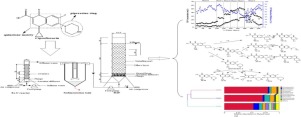当前位置:
X-MOL 学术
›
J. Hazard. Mater.
›
论文详情
Our official English website, www.x-mol.net, welcomes your
feedback! (Note: you will need to create a separate account there.)
Enhanced phosphorus and ciprofloxacin removal in a modified BAF system by configuring Fe-C micro electrolysis: Investigation on pollutants removal and degradation mechanisms
Journal of Hazardous Materials ( IF 12.2 ) Pub Date : 2017-09-08 , DOI: 10.1016/j.jhazmat.2017.09.010 Longlong Zhang , Qinyan Yue , Kunlun Yang , Pin Zhao , Baoyu Gao
Journal of Hazardous Materials ( IF 12.2 ) Pub Date : 2017-09-08 , DOI: 10.1016/j.jhazmat.2017.09.010 Longlong Zhang , Qinyan Yue , Kunlun Yang , Pin Zhao , Baoyu Gao

|
A modified biological aerated filter (BAF) system configured Fe-C micro electrolysis was applied to enhance phosphorus and ciprofloxacin (CIP) removal. A novel sludge ceramic and sintering ferric-carbon ceramic (SFC) were separately packed into a lab-scale BAF and Fe-C micro electrolysis reactor. The BAF and Fe-C micro electrolysis coupled system was operated about 230 days. The enhancement of phosphorus and ciprofloxacin removals by Fe-C micro electrolysis, the degradation mechanisms of CIP and the variations of microbial population were investigated. The removal efficiencies of chemical oxygen demand (CODcr), ammonia (NH4-N), total phosphorus (TP) and CIP reached about 95%, 95%, 80% and 85% in the combined process, respectively. Configuring Fe-C micro electrolysis significantly enhanced phosphorus and CIP removal, whereas had no promotion on N removal. Four main degradation pathways were proposed according to the LC–MS analysis. More than 12 degradation products were detected through the treatment of Fe-C micro electrolysis and only 3 biodegraded products with low concentration were identified in BAF effluent. The high-throughput sequencing analysis showed that the microbial community changed a lot under CIP pressure. The relative abundance of Sphingomonadaceae, Xanthomonadaceae, Bradyrhizobium, Helicobacter and Pseudomonas increased with CIP influent. This study provides a promising process in CIP wastewater treatment.
中文翻译:

通过配置Fe-C微电解,在改良的BAF系统中提高了除磷和环丙沙星的能力:污染物去除和降解机理的研究
配置Fe-C微电解的改进的生物曝气滤池(BAF)系统应用于增强磷和环丙沙星(CIP)的去除。将新型污泥陶瓷和烧结铁碳陶瓷(SFC)分别装入实验室规模的BAF和Fe-C微电解反应器中。BAF和Fe-C微电解耦合系统运行约230天。研究了Fe-C微电解对磷和环丙沙星去除的促进作用,CIP的降解机理以及微生物种群的变化。化学需氧量(COD cr),氨气(NH 4)的去除效率-N),总磷(TP)和CIP在合并过程中分别达到约95%,95%,80%和85%。配置Fe-C微电解显着提高了磷和CIP的去除率,但对氮去除没有促进作用。根据LC-MS分析,提出了四个主要降解途径。通过Fe-C微电解处理检测出12种以上的降解产物,而BAF废水中仅鉴定出3种低浓度的生物降解产物。高通量测序分析表明,在CIP压力下,微生物群落发生了很大变化。鞘脂菌科,黄单孢菌科,缓生根瘤菌,幽门螺杆菌和假单胞菌的相对丰度随CIP进水而增加。这项研究为CIP废水处理提供了有希望的过程。
更新日期:2017-09-09
中文翻译:

通过配置Fe-C微电解,在改良的BAF系统中提高了除磷和环丙沙星的能力:污染物去除和降解机理的研究
配置Fe-C微电解的改进的生物曝气滤池(BAF)系统应用于增强磷和环丙沙星(CIP)的去除。将新型污泥陶瓷和烧结铁碳陶瓷(SFC)分别装入实验室规模的BAF和Fe-C微电解反应器中。BAF和Fe-C微电解耦合系统运行约230天。研究了Fe-C微电解对磷和环丙沙星去除的促进作用,CIP的降解机理以及微生物种群的变化。化学需氧量(COD cr),氨气(NH 4)的去除效率-N),总磷(TP)和CIP在合并过程中分别达到约95%,95%,80%和85%。配置Fe-C微电解显着提高了磷和CIP的去除率,但对氮去除没有促进作用。根据LC-MS分析,提出了四个主要降解途径。通过Fe-C微电解处理检测出12种以上的降解产物,而BAF废水中仅鉴定出3种低浓度的生物降解产物。高通量测序分析表明,在CIP压力下,微生物群落发生了很大变化。鞘脂菌科,黄单孢菌科,缓生根瘤菌,幽门螺杆菌和假单胞菌的相对丰度随CIP进水而增加。这项研究为CIP废水处理提供了有希望的过程。











































 京公网安备 11010802027423号
京公网安备 11010802027423号